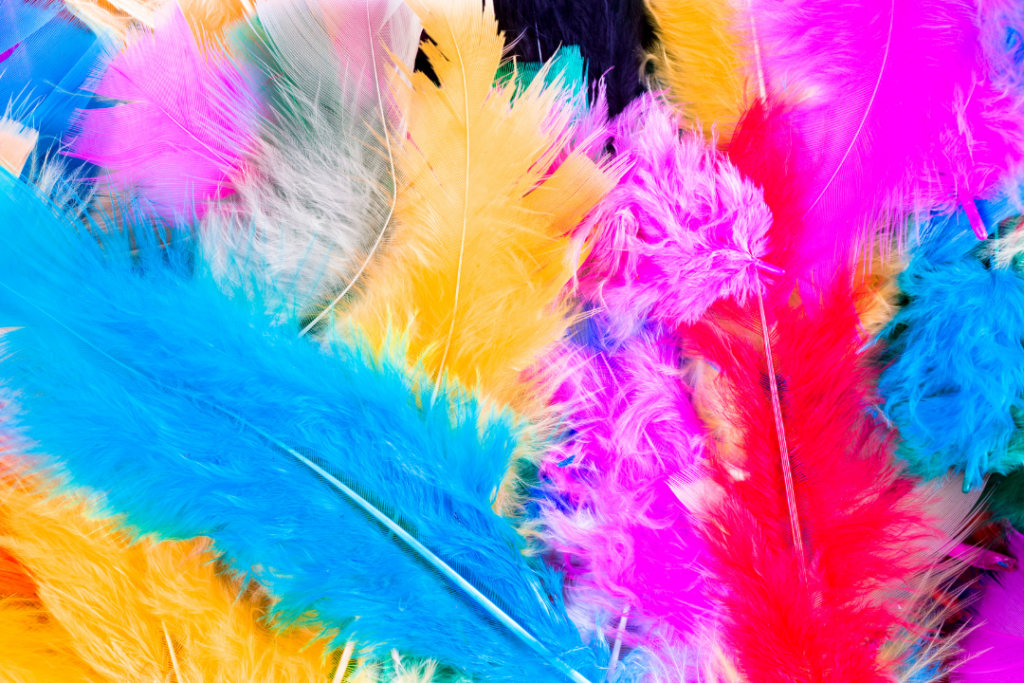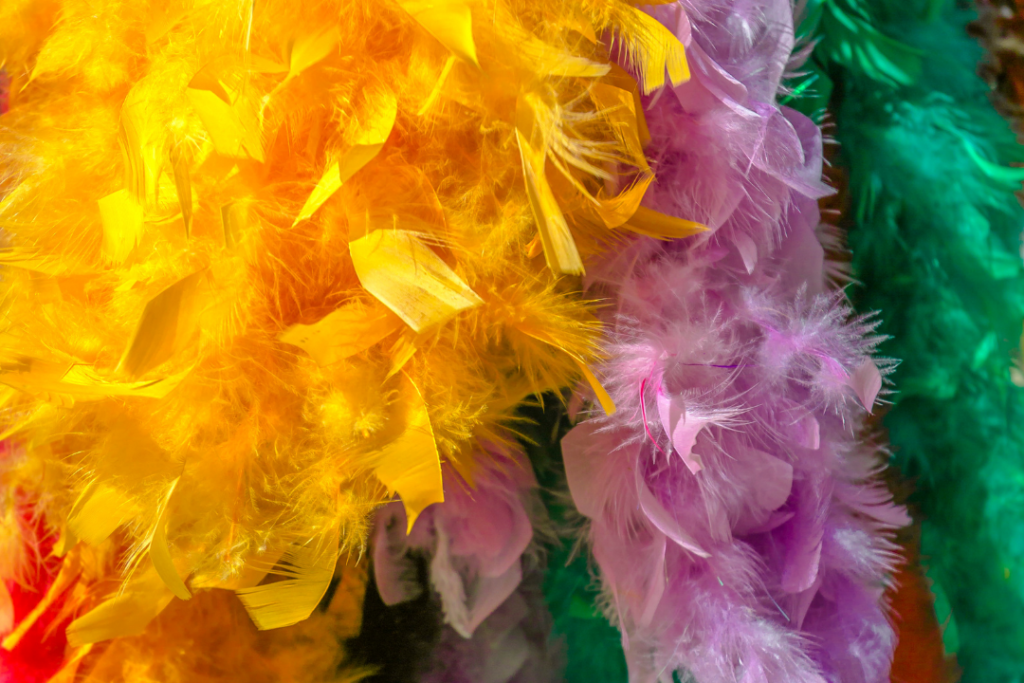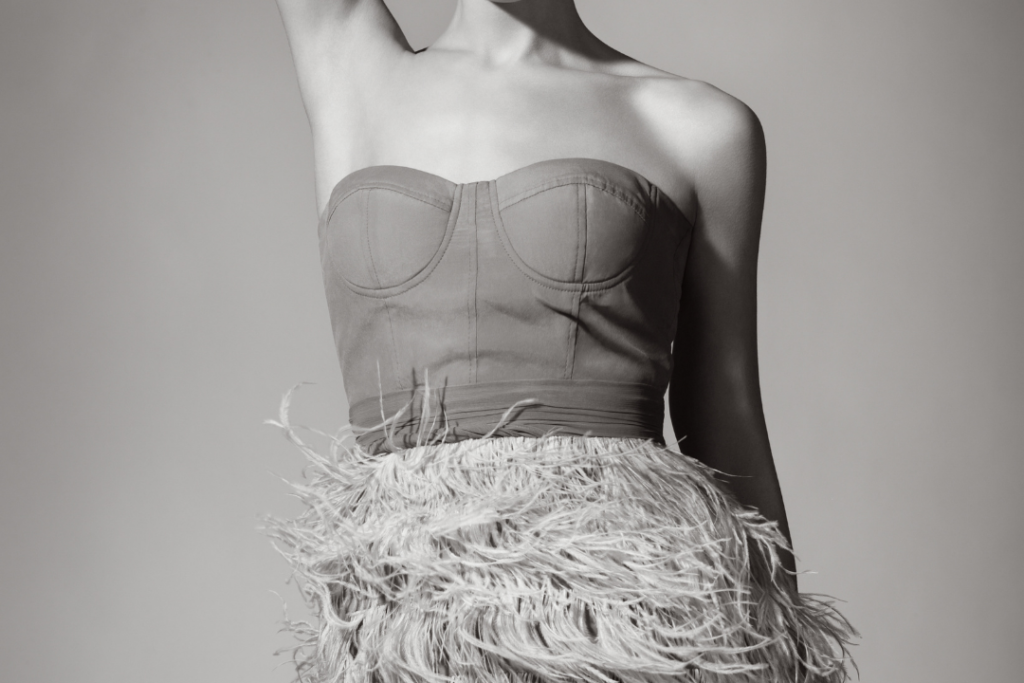
Feathers are everywhere in the fashion world lately. From the ubiquitous feather hair extensions, to jewelry, to prints and textiles evoking these stylish fowl, feathers are no longer just for costumes or haute couture. Feathers have gone mainstream, and with their rise to fame, my curiosity has reached new heights.
Were feathers always fashionable? What are the roots of feathers as clothing decorations? To find out, read on for info on the history of feathers in fashion.
Table of Contents
History of Feathers in Fashion

- While completing research for this post, I was surprised to find an article on fashionable feathers among, get this, Neanderthals. While investigating a cave near Verona, Italy, paleoanthropologist Marco Peresani and colleagues found 660 bird bones. “Cut, peeling and scrape marks are observed exclusively on wings, indicating the intentional removal of large feathers,” he stated. Peresani believes the bird feathers were used for ornamentation and not another, more practical purpose. Of the 22 bird species found de-feathered, most were not known to be good food sources, and during investigation, it was evident that only certain feathers were plucked. “[They] removed the remiges, which are the longest and more beautiful feathers,” Peresani said. Makes you wonder what else Neanderthals were rocking…
- Native American headdresses are another early example of feathers being used for ornamentation. While most TV and movie depictions of historical Native Americans feature the feathered war bonnet (also known as a “war bonnet”), bonnets “were actually only worn by a dozen or so Indian tribes in the Great Plains region, such as the Sioux, Crow, Blackfeet, Cheyenne, and Plains Cree,” according to Native Languages of the Americas, a non-profit organization dedicated to the preservation of Native American languages.
- Another interesting fact about war bonnets that pop culture often gets wrong: Historically, they weren’t worn every day – instead, they were reserved for special occasions only… and women did not wear them! According to the Wiki page, they “were worn by honored Plains Indian men, sometimes into battle, but most often for ceremonial occasions, and were seen as items of great spiritual and magical importance.”
- In addition to war bonnets, other traditional Native American headdresses utilize feathers, including the roach bonnet, made of stiff animal hair with feathers incorporated into it, and feather headbands, made with eagle, crane, and/or egret feathers, to name a few. To see a history of headdresses as provided by the Native Languages of the Americas organization, click here.
- Like I mentioned in my last post on the history of masquerade masks, feathers were also used as decorationfor masks in 16th-century Europe. Traditionally reserved for aristocrats only, these accessories gradually became more accessible to the lower classes.
- In the 20th century, feathers made a splash in fashion during the flapper era, as dresses were festooned with feathers to create more movement. Entertainers, too, used feather boas to enhance their performances.
- We’re still inspired by the feather in our fashion today. While it may not be practical to wear head-to-toe feathers on an everyday basis, it’s always fun to play with the feathers-as-fashion trend. If you’d like some inspiration, check out our post on fashion from Black Swan to get some ideas!
Why We Still Love This Trend

Earlier in this series, we played a game of fill in the blank. Ready to play again? If you could choose three words to describe the feathers and their position in fashion, what would you say? While I wait to read your responses, here are mine:
- Colorful. Feathers are vibrant and eye-catching, perfect for dressing up your fall neutrals. Try a blouse with an all-over feather print under a sweater for class, a feathered skirt or dress for an evening out, or a chic hair accessory for a unique touch to any ensemble.
- Breezy. For those with a more carefree, relaxed style (think Doub Hanshaw for Free People), feathers are for you! Because of their diffusion into more casual fashion, gone are the stereotypes that feathers are uptight, stuffy, or just for special occasions. Be inspired by the birds and add some feather accents to your wardrobe for some nonchalant ease.
- Whimsical. There’s something inherently fun and unconventional about feathers in fashion, and for someone who has a self-proclaimed classic sense of style, I love the unexpected touch they add to an ensemble.
Thoughts?
How would you fill in the phrase “Feathers are ____”? Are you a fan of feathers in fashion? Would you ever wear clothing composed of feathers, or will you stick to accessories? What do you think of the feather hair extensions craze? Any other trends you’d like to see covered next in this series? Leave a comment!

I’m allergic to feathers. If I’m going to wear dead animal parts, I’d rather wear vintage animal fur. There’s a very un-pc rabbit fur coat of my mom’s that I’d love to wear.
I just bought a feather headband similar to the Etsy ones in the link, so excited to wear it!
Fun – Flirty – Floaty (is that a word?) Feathers seem to mark you as a free spirit and while it’s a trend you can’t take too seriously, it does have flair! Thanks for the research, Rachel – it’s always interesting.
Everyone is making excellent points concerning ethics and respect. I chose the feather for this article because I found it to be aesthetically interesting, and I’m glad we can discuss these other aspects of the topic as well. Thank you for your input!
I used to own chickens (as pets) and when they would molt I’d pick up the old feathers and wear them in my hair (after washing them of course).
Feathers can be beautiful, but I’d hate to wear real ones if I didn’t know where they came from or how they were retrieved. As it is, I’d love the feathery 20s esque skirt–however, I’d go with fake feathers. 🙂 I wouldn’t want any birds to be harmed for my clothing.
I also agree with Emma’s comments. I actually came to the comments section to write something similar but she beat me to the punch. 🙂
I think that this is a great article that really shows the fun way in which feathers can be used in today’s culture. I am a descendant of the Cherokee nation and I personally have a feather and an extension. I do not find them offensive at all. I personally think it’s a great way to show your heritage and personality. I am sure that the animal the feather came from is no less happy without that one feather. If you prefer to not use animal feathers there are plenty of fun synthetic feathers. So everyone can enjoy!
I understand the importance of ethics, but this piece isn’t a “how to” on plucking animal feathers and mimicking other cultures. There are plenty of feather options that are synthetic. Let’s focus on the point of this article, feathers are a great way of sprucing up a look and strutting a little on the wild side (excuse the pun). They make a great focal piece to any basic outfit when used as an accessory. Feathers also have the ability to play a more subtle roll, as in the hair pieces, or the pattern of feathers on fabric. Great article!
Exactly what Emma said. If there’s going to be a discussion about feathers in fashion, I think it’s extremely important to explain the difference between following a trend and culture appropriation. This blog has excellent posts on the subject: mycultureisnotatrend.tumblr.com
Feathers are so whimsical I love them in skirts
Interesting article, but what isn’t mentioned is that the oh-so-popular feather hair extensions and many other uses of feathers harm animals.
Next time you think of getting feathers put in your hair, match the look of the feather to what animal it came from. You will soon find that a rooster’s rear end looks identical to your “fashion statement”. If I were a rooster, I wouldn’t want my butt plucked so you could wear it next to your face. Just a thought (:
I agree with Emma. It’s fine to use feathers to make fashion statements as long as they’re not used offensively.
It’s very important that feather pieces don’t seek to “emulate” Native American uses of feathers–it’s cultural misappropriation and trivializes Native American culture. Dream catchers; anything called “Navajo” (for example, other use of tribe names without permission too); and feathers mimicking Native American cultural use, such as war bonnets, without actually following the specific customs in regard to that use of feathers are ALL out. It’s offensive, insensitive, and ignorant.
I like feathers, but a lot of people make these mistakes when wearing them. I prefer 20s inspired feather pieces because they’re retro and don’t offend anyone!
Feathers are dreamy. I love the way the marabou on the cuffs of my favorite sweater catch the slightest movement and wave like they’re underwater. I’ve always been a fan of feathers.
I love the look of feathers, but I worry about the ethics of it. I try to avoid things that come from an animals body, especially ones that they had to suffer/die to give up.
On a more cheerful note, that’s really fascinating about the Neanderthals! I always love hearing about the History behind trends, particularly when it goes so far back.